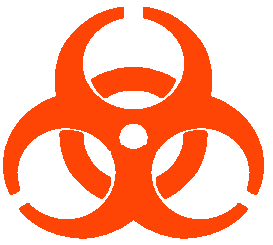Biosafety for Maintenance Personnel
Know the Universal Biohazard Symbol!

- Biosafety means the safe work practices and proper use of personal protective equipment when handling biohazardous materials.
- Never Eat, Drink, or Smoke in a Biohazardous Lab.
- In a biohazard lab, just because a container or piece of equipment is not labeled, does not mean that it is clean. Always ask !
- Never move a piece of equipment unless you have asked. Never handle suspicious material. Always ask!
- Any piece of Equipment in a Biohazard area can be contaminated. This includes: Pumps, storage cabinets, freezers, waste containers, bags, or equipment used to transport or hold Biohazardous materials. Always ask!
- All gloves are not alike. Never touch yourself, especially your face or eyes, when wearing gloves. Always wash your hands after removing gloves.
- You must never clean up any materials that you spill in a lab. Contact you supervisor, someone in the lab, or the Physical Plant Base station – Control 1 on the Radio or 7087 by phone.
- If you forget any of this information, or if you ever have any questions, contact your supervisor or Health and Safety. Stop what you are doing until you are sure that it is safe. Never be afraid to ask questions.
- Typical Biohazardous materials used on the campus are: Blood, Body Fluids, Cells, Tissues, Infectious Microbes
- The purpose of containment and special work practices is to prevent accidental exposure.
- Exposure means the accidental transmission of a disease to a worker who enters an area to perform a service. Biohazardous materials cause infections.
- Accidental exposures most commonly occur through direct contact (touching) with: Broken or diseased Skin, the Eyes, the Nose and the Mouth.
- Contaminants can enter the body through: Puncture Wounds, Needle Sticks, Cuts or Abrasions
- Areas that use biohazardous materials will always be identified with the Biohazard symbol.
An Exposure control Plan tells you :
- Where biohazardous materials are used,
- What Jobs are at risk,
- Confinement procedures,
- Personal Work Practices,
- Protective Equipment to use,
- Where Immunizations are required
- (None are required for maintenance personnel since you are not expected to work with these materials), and,
- Medical Responses to accidents
The training you received is not everything you need to know. Your supervisor will update you periodically, lab personnel will tell of specific hazards in their areas.
Biohazard Levels on our campus :
- BL-1 Small risk
- BL-2 Moderate risk, primarily Labs that use blood or tissue (highest level we have)
- Most injuries are due to cuts, direct contact with materials and eye contact.
Biohazard Levels NOT on our campus:
- BL-3 Germs are cultured and they can be transmitted through the air
- BL-4 Exotic Areas
Basic Universal precautions are :
- Learn where biohazardous materials are used. Look for the symbol.
- Use common sense when working near these materials.
- Always wash your hands after leaving these areas.
- You will not be working with biohazardous materials, you need no special inoculation or shots.
- If you are on any medication and have to work in these areas, let your physician know. Let your supervisor know if your doctor says that it increases your exposure risks.
Report all accidents, no matter how small, even a scrape, if they occur in a biohazardous lab.
If others are working in a lab, use their protective clothing and gloves as a guide to what you should be using. You should always use the same type of protection as the people in the lab.
The University will always provide any protective equipment that you need to work safely in our job.